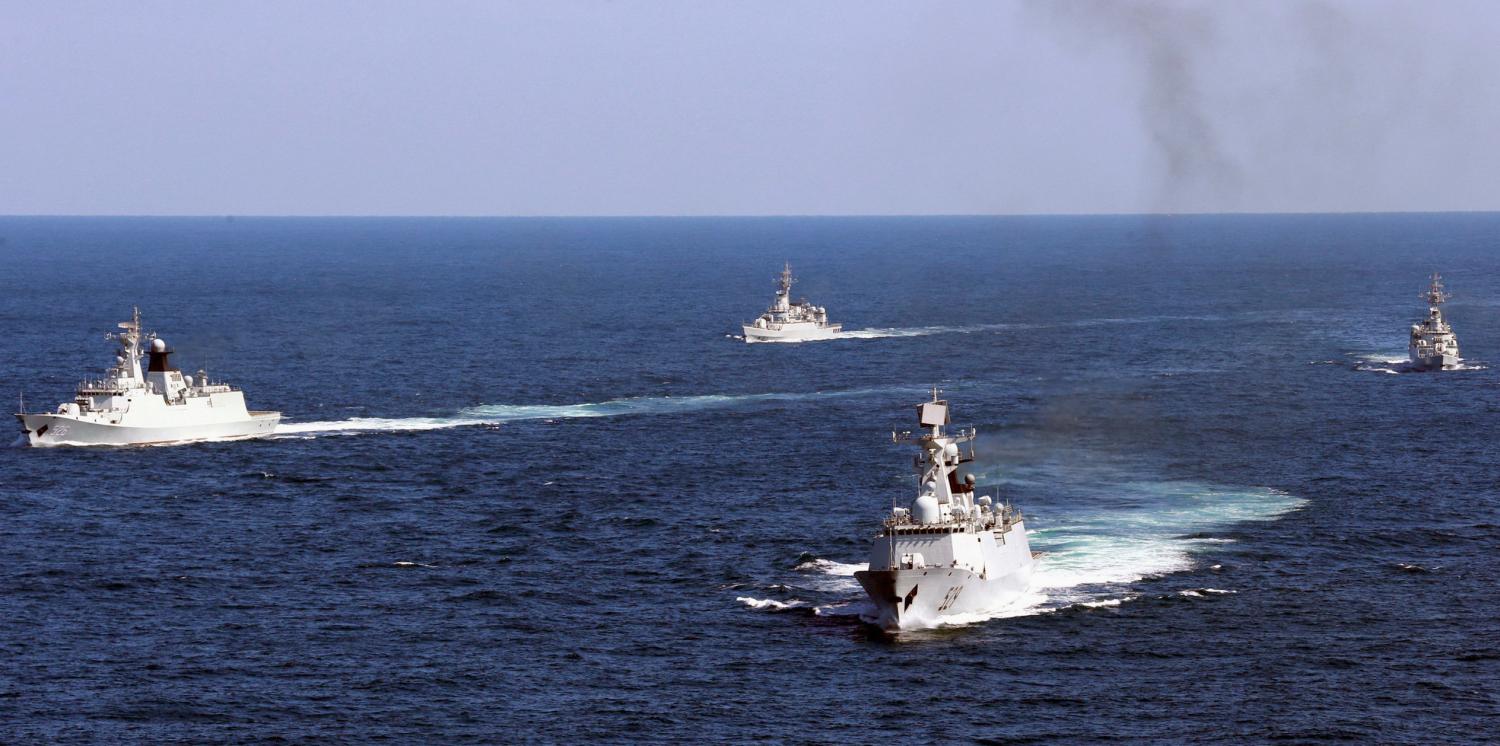The United States has long sought to foster an environment in East Asia that is conducive to peace, stability and prosperity. Yet an intensifying contest for resources is destabilizing the maritime domain in the East China Sea and South China Sea. Richard Bush, Bruce Jones, and Jonathan Pollack wrote this memorandum to President Obama as part of Big Bets and Black Swans: A Presidential Briefing Book.
- What should the U.S. do to encourage China, Japan, and others to avoid conflict?
- How can agreements between the United States and the Soviet Union during the Cold War serve as a guide for regulating interaction at sea?
- How can cooperation in the Arctic serve as a model for multilateral cooperation in East Asia?
Download Memorandum
(pdf) |
Download the Presidential Briefing Book
(pdf)
TO: President Obama
FROM: Richard Bush, Bruce Jones, and Jonathan Pollack
Maritime East Asia is becoming increasingly dangerous. The past 12 months have seen a series of crises and spats in the East China Sea and South China Sea that threaten to spiral out of control. The twin sources of danger are 1) how regional actors conduct maritime operations to assert and/or defend claims to territory and natural resources’ rights; and 2) their weak capacity to conduct crisis management under domestic nationalistic pressures. The United States risks becoming entangled in conflicts among countries that are its friends and partners.
Recommendation:
You have the opportunity to mitigate the danger of future physical clashes by mounting a concerted diplomatic effort to encourage the countries concerned jointly to adopt conflict-avoidance mechanisms in the near term and to promote more institutionalized risk-reduction measures in the medium term. This will both serve U.S. interests in avoiding unnecessary entrapment and foster an environment conducive to cooperative exploitation of resources.
This could be pursued both at the regional and international levels. During the Cold War, the United States concluded risk-reduction agreements with the Soviet Union to regulate the interactions of its naval ships and air force planes. There has been recent work by the United Arab Emirates, Australia and India to foster better exchange of lessons, build private and public sector capacity, and share information about crisis-mitigation tools at the international level; diplomatic efforts to build on this could provide useful context to regional efforts and minimize a sense that China is being singled out.
Background:
The United States has long sought to foster an environment in East Asia conducive to peace, stability and prosperity. Yet an intensifying contest for hydrocarbon, mineral and fishery resources among regional actors is destabilizing the maritime domain. For resource reasons, China, Taiwan and Japan each claim the Diaoyu/Senkaku Islands northeast of Taiwan while China, Taiwan and several Southeast Asian countries claim various land forms in the South China Sea. Conflicts have become more intense in recent years because China is acquiring the seaborne capabilities to assert its own claims and challenge those of others. Growing nationalist sentiment in all countries pressures leaders to take strong stands and eschew compromise. Physical clashes have occurred, which have illustrated the weak crisis management capacity of the countries concerned. In this environment, the prospect for mutually-beneficial cooperation in the exploitation of resources is low (international energy companies, for example, are reluctant to undertake major projects in contested areas).
The United States takes no position on which country owns which land form. But Washington has strongly advocated the freedom of navigation for all countries, the peaceful settlement of disputes, and using international law in addressing questions of sovereignty and resource exploitation. China’s recent and more assertive behavior in defining and advancing its claims — still non-violent but decidedly coercive — has been contrary to those U.S. interests.
In addition, treaty obligations threaten to entangle the United States in specific ways. The U.S.-Japan mutual security treaty applies to all territories under Japan’s administrative control, which includes the Senkaku Islands. According to the long-standing American position, the U.S. mutual defense treaty with the Philippines does not apply to land forms in the South China Sea, but it does apply to “Philippine vessels.” At a minimum, these legal commitments create the potential for a “tail wags the dog” situation. In a crisis, they entail the fundamental credibility of the United States to stand by allies.
The proximate source of the current danger is the physical clashes and standoffs between vessels of the claimant countries, which are growing more common. Although none has crossed the threshold of loss of life, that may be only a matter of time. Clashes at any level are not in the U.S. interest, because they force the United States to choose among countries with which it seeks good relations. Trying to mediate the underlying territorial disputes would be a fool’s errand, and your administration should not try. Nor should you try to facilitate resource-sharing agreements among the claimant countries as long as the current fevered environment continues.
But the United States has both the need and the opportunity to facilitate a reduction in the probability of physical clashes and the attendant tensions — to the benefit of all. Your administration should continue to counsel restraint among the contenders (China has deservedly become the main target of such demarches). In the near term, it should mount a diplomatic effort to encourage the countries concerned to adopt conflict-avoidance mechanisms jointly. In the medium term, it should promote more institutionalized riskreduction measures to regulate the operations of their maritime agencies.
The United States created such mechanisms with the Soviet Union during the Cold War to regulate interaction at sea and in the skies over Berlin. Current and retired U.S. naval and air force officers are a repository of experience on how to conduct conflict-avoidance and risk-reduction measures. The United States should also explore ways to root these efforts in a global framework, drawing on lessons from the management of the Arctic, which has been something of a good news story for international cooperation in recent years.
At this juncture, Japan is quietly willing to develop a conflict-avoidance/ risk-reduction regime for the East China Sea. The ASEAN states are committed to concluding a binding code of conduct with China for the South China Sea for that same purpose. But China has been reluctant and has erected obstacles to a cooperative and stabilizing solution. Beijing has insisted that it will not talk to Japan until Tokyo is prepared to acknowledge that a territorial dispute over the Senkakus exists (Japan is reluctant to do so because it fears that such acknowledgment will be followed by a Chinese demand for negotiations). Concerning the South China Sea, China has used its close ties with Cambodia to delay and deflect any action on a binding code.
Your administration can play a behind-the-scenes role in breaking these logjams. You should start with engaging Beijing’s new leader and stressing to them that China should have little interest in suffering the reputational effects of its coercive behavior or the problems that come with a true crisis. Instead, it is in China’s interests to step back from these conflicts and focus on what is really important. A conflict-avoidance/ risk-reduction regime is a low-cost, face-saving way to do that. Second, as an inducement to China and in return for strongly supporting Japan on such a regime, you should urge Tokyo to bifurcate its position on the Senkakus: retain its de jure position that the islands are Japan’s (so no dispute exists), but acknowledge that de facto other states have their own positions which they are free to present in the course of negotiations on other issues. Concerning a South China Sea code of conduct, you should first firm up support among claimant and other like-minded countries for a code of conduct that is strong enough actually to avoid conflict and reduce risk. Next, with their concurrence, you should suggest to China that if it continues to block a code by splitting ASEAN, the claimant countries and others that support a strong code will, with the support of the United States and others, have no choice but to negotiate with China as a “coalition of the willing.”
Conclusion:
The United States has absolutely no interest in going to war to protect the honor of friends and allies over small rocks and islands. Should it become necessary to contend with China to protect U.S. interests in East Asia and to buoy the confidence of American friends, it should be over a more consequential issue. With a modest yet concrete effort, you have the opportunity to reduce the salience and danger of an issue that will only inflict more headaches. Stabilizing the situation in East Asian waters will mitigate the danger of future clashes and also foster an environment in which cooperative exploitation of resources is more likely.
The Brookings Institution is committed to quality, independence, and impact.
We are supported by a diverse array of funders. In line with our values and policies, each Brookings publication represents the sole views of its author(s).






